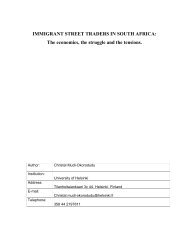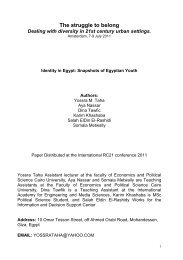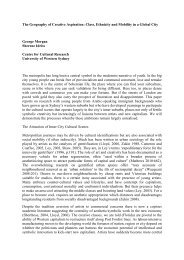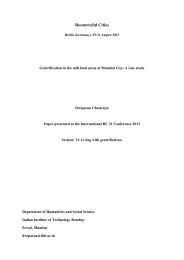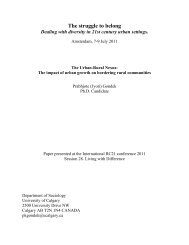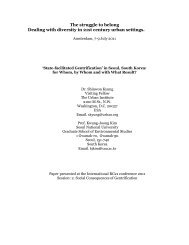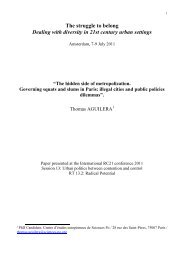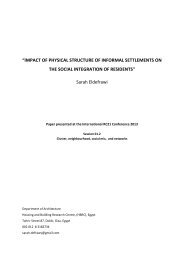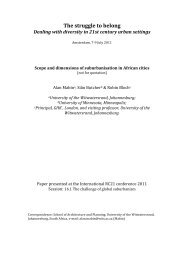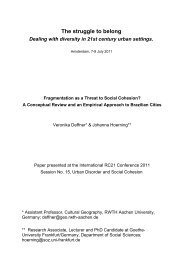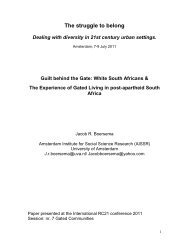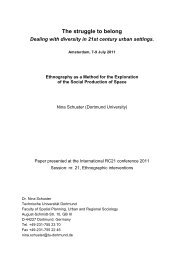Gentrification as a broad process of reurbanization - RC21 ORG ...
Gentrification as a broad process of reurbanization - RC21 ORG ...
Gentrification as a broad process of reurbanization - RC21 ORG ...
Create successful ePaper yourself
Turn your PDF publications into a flip-book with our unique Google optimized e-Paper software.
Judit Veres CEU Budapest<br />
League – (Magyar Kommunista Ifjúsági Szövetség) itself established in 1957, March<br />
27. It w<strong>as</strong> set up with the intention to <strong>of</strong>fer a place for Hungarian artists and<br />
intellectuals and it had acquired along the years the reputation <strong>of</strong> an underground<br />
cultural hub in the capital by the time it w<strong>as</strong> closed in the 90s. Considered by many to<br />
have significantly contributed to the emergence <strong>of</strong> the Hungarian artistic<br />
underground, it w<strong>as</strong> also one <strong>of</strong> the most closely observed cultural venues, and<br />
György Aczél himself the most influential person in the cultural policy <strong>of</strong> the Kádár<br />
era regarded it <strong>as</strong> a perfectly safe valve <strong>of</strong> expression. (true, by the eighties it w<strong>as</strong><br />
already possible to criticize the regime). It w<strong>as</strong> a place which w<strong>as</strong> more tolerated by<br />
the political establishment than other similar cultural venues such <strong>as</strong> the Almássy<br />
Hall, the old Mozgó Világ, Tilos az Á, Fekete Lyuk supposedly more avant-garde and<br />
critical <strong>of</strong> the political and cultural establishment.<br />
“Although it w<strong>as</strong> a good little place, the city’s freest place, policeman did not really<br />
step in here, <strong>as</strong> the place w<strong>as</strong> run by the police“. (Deák L<strong>as</strong>zló). This quotation<br />
succinctly expresses the contradiction at the heart <strong>of</strong> FMK‗s existence, the complexity<br />
<strong>of</strong> this urban space, its freedoms and limits, in the otherwise far from monolithic and<br />
incre<strong>as</strong>ingly slackening grip <strong>of</strong> a state from almost total control to the liberty to<br />
virtually say and do anything. Only the politically absolutely critical exhibitions were<br />
banned at FMK by the eighties, for instance, under the pretext <strong>of</strong> a leaking pipe. In<br />
FMK‗s place now at Andrássy 112 one finds the chic private gallery Kogart, which<br />
attempted to recreate through an exhibition in 2005 the be-gone greatness <strong>of</strong> FMK,<br />
without much success.<br />
The other famous urban cultural venue during socialism, the Almássy Hall opened in<br />
1983 and it w<strong>as</strong> one <strong>of</strong> the biggest investments <strong>of</strong> the 6th 5-year plan. Initially (1976)<br />
it w<strong>as</strong> planned to be a pioneer house before the decision in 1982 to turn it into a<br />
recreation centre (Almássy téri Szabadidő Központ). In many respects it w<strong>as</strong> much<br />
more <strong>of</strong> an alternative place than FMK or PeCSa, true, it started operating in the<br />
eighties during a politically less repressive decade. The place housed the first album<br />
<strong>of</strong> Első Emelet, which in 1985 introduced the Dire Straits concert. The year 1987 w<strong>as</strong><br />
the most eventful when Club 2000, Bonanza Bonzai started and then in 1988 The<br />
Almássy Hall got involved in the year‘s scandal when a Dutch group consisting <strong>of</strong> ten<br />
people performed stark naked at a time when nudity w<strong>as</strong> seen by the establishment <strong>as</strong><br />
a serious affront to socialism.<br />
13



